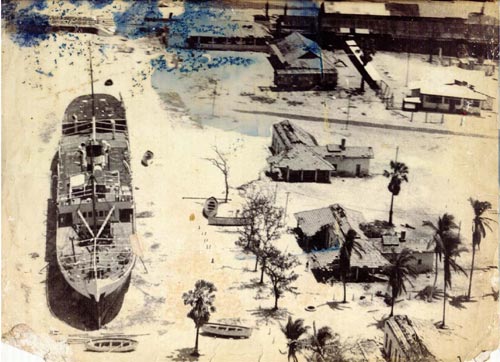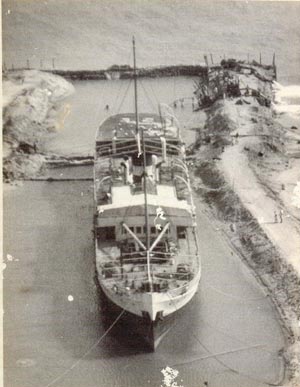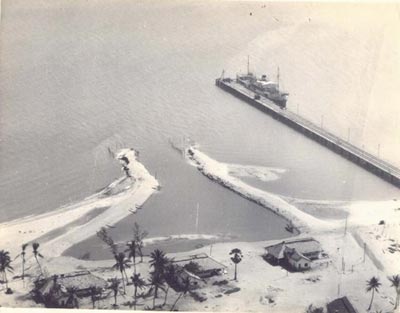“Operation Goshen”- A chapter in the story of the Indo-Ceylon ferry
View(s):With the ferry service between India and Sri Lanka re-commencing after almost 60 years, Lt. Commander Somasiri Devendra shares an interesting story of how the service came to be disrupted.
Writes Lt. Commander Devendra: “It was because the last ferry, SS Goshen, was lifted by Cyclone “Emily” in 1964 and cast ashore, high and dry, though yet water-tight. The ship was salvaged without harm and re-floated by the new Diving Unit of the Royal Ceylon Navy.
The operation was conducted by (the late) Cdr (E) Eustace Matthysz, senior-most Maritime Engineer in the Navy. Cdr. Matthysz had promised me his memoirs in his retirement but with his health deteriorating, he was able to complete only the period about the cyclone which struck Ceylon in 1964. He gave me these papers a day or two before he passed away.
Here from his papers, is the section about ‘Operation ‘Goshen’ with photographs from Vice Adm. Priyantha Perera, Commander of the Navy.
By Cdr (E) E.L.Matthysz

“Goshen” has ‘landed’
Sometime in March (1965), Commodore Kadirgamar summoned me to come to Colombo as early as I could. I attended the conference and the decision was that we should undertake the salvage operation of the Indian ferry “Goshen” which had been left high and dry at the time of the cyclone, beached well and truly on the Talaimannar beach within 100 to 150 yards from the Talaimannar Pier.
The vessel was understood to be parallel to the beach, so I returned to Trincomalee and formulated what was necessary for this salvage operation. My team consisted of Lt. Marty Somasundaram, Inst. Lt. H.D.L.M. Palmon and Lt. K.K. Fernando, Steward Kandasamy, all members of the newly formed Diving Unit and civilian dockyard workers mainly from the Fire Brigade.
The convoy was prepared with cooking utensils, bedding, a small generator, our communication sets and the necessary essentials to strike camp.
We took off from Trincomalee and came to Talaimannar Pier around 3rd or 4th March. We had to occupy a damaged Customs building, which, with a few renovations, was repaired sufficiently for us to occupy while conducting the operation of the salvage which was within 100 yards of our building. We lost no time getting down to business.
We spent a quiet evening and of course established a source from which we could get our good “old stuff” – sometimes from Talaimannar and sometimes the bus used to bring it all the way from Mannar. Conversation that whole evening was on how this operation was to be conducted. The next morning we got down to work.
With the assistance of the Railway we used some of their material with the idea of putting these rails under the “Goshen” and quietly moving her towards the water. After a few days, we abandoned it because we found the “Goshen” too heavy. Every time we put a railway line under it, it disappeared under the sand.

Afloat in the basin
Then with the assistance of the Railway Department, we obtained a bulldozer (that took us a few days). When it came, we built a complete basin out of sea sand round the “Goshen”. Calculations were made to accommodate depth and the volume of water needed. The edges of the basin had to be built sufficiently high to accommodate the vessel when she floated slightly.
While this was going on, there was very little we could do except watch. It gave us a few days to look around Talaimannar, especially the fishing villages and the Roman Catholic church.
Many people from around the area got to know of this operation and visited the site. We got into conversation with a few of them and there was one person in particular who interested me; a portly fisherman’s wife who came with a few children in one of the fishing wadi vans.
She told us of the cyclone reaching their village and water coming up so fast that she picked up her 2 or 3 children under her arms and proceeded to higher ground. There they met the Parish Priest and told him that he must do something “religious” to try to stop this water which had now reached the church compound. So the priest brought the statue of St. Mary to this place and dipped it in the sea and within half an hour the waters appeared to recede. I was intrigued because it was the fisherman’s wife who explained this as a miracle.
Every evening, we got into the jeep and proceeded to the Pesalai toddy tavern and consumed a little toddy and fried salayas. I really enjoyed the thirst quencher at the end of our operation for the day.
In the meantime, the basin created by the bulldozer was being filled with water for nearly 1-1/2 days and while this was being done, we had a certain amount of rest except the anxiety of wondering how the sand basin could withstand the weight of the water in this big basin. We made allowances for seepage and as it gradually filled and came to about 5 inches to the brim, we tried pulling the “Goshen” but it would not budge.
Something had gone wrong with our calculation, but Lt.Cdr. Palmon assured us that it had to come up about 1 or 2 inches more.

Out of the basin, back at the pier
We were reluctant to put pressure on the banks of the basin even with the help of others and our own crew. But the filling went on and finally, amid great joy and excitement, it began to move with just 2 inches from the brim of the basin. We then continued to pump a little more, taking a risk and the “Goshen” moved in the basin and we walked her to a position parallel to the Talaimannar pier.
Meanwhile we had to be careful not to let the bows of the vessel touch the sand basin. Having positioned her into place, Lt. Somasunderam and his team of divers prepared stacks of dynamite in preparation for the breaching of the basin, so that with the outflow of water there would be some momentum in the vessel forcing its way out.
The next day was a day of further excitement and this preparation was more or less ready. We were joined by an official from the Indian Railways Mr. Ragunathan. Because the bulldozer was an Indian Railway bulldozer, he was most helpful as he was also a mechanical engineer.
The time and tide were taken into consideration and the sand basin was breached. The vessel surged forward with the help of a number of people pulling on ropes that were fitted to the vessel. Nothing tangible took place except that the vessel came halfway past our breached sand bar and got stuck. The end result was that the divers had further work to high pressure hose the bottom to relieve the vessel from sitting on the sand.
By this time, I had learned my lesson – I got Amoebiasis by drinking toddy and informed Naval Headquarters of my position. I had no alternative but to return to Colombo and enter the Military Hospital on the directions of the Commander of the Navy. So I took the train the same night seeing the vessel stuck halfway and left the balance work to Lts. Somasunderam and Palmon.
I got admitted at the Military Hospital the next morning and I received the news through Dr. Vernon Fernando who visited me that evening that the “Goshen” was finally salvaged. I was only sorry I could not wait for the final salvage operation.
After a few days, according to Lt. Somasunderam, they left Talaimannar and returned to base (Trincomalee) triumphantly having completed a task that has never been undertaken in the method we adopted ever before in Sri Lanka. Some of the equipment like the Naval Fire Brigade pumps were ruined because of the friction with salt water and sand.
Searching for an ideal partner? Find your soul mate on Hitad.lk, Sri Lanka's favourite marriage proposals page. With Hitad.lk matrimonial advertisements you have access to thousands of ads from potential suitors who are looking for someone just like you.


